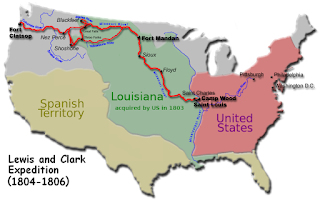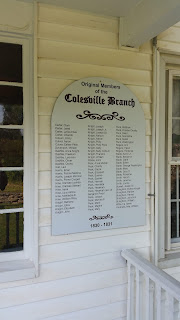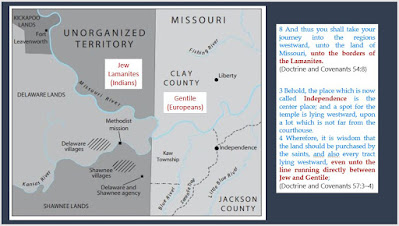As I mentioned in part 1, D&C 128 provides us with one of the keys to understanding the historicity of the Book of Mormon: the New York Cumorah.
Once we accept the teachings of the prophets about the Hill Cumorah--that the hill in New York where Joseph found the plates is the same hill referenced in Mormon 6:6--we can be confident that the book is a translation of an actual history, involving real people in a real place.
Rejecting those teachings has led to lots of confusion among Latter-day Saints.
Let's review the verse.
20 And again, what do we hear? Glad tidings from Cumorah! Moroni, an angel from heaven, declaring the fulfilment of the prophets—the book to be revealed. A voice of the Lord in the wilderness of Fayette, Seneca county, declaring the three witnesses to bear record of the book! The voice of Michael on the banks of the Susquehanna, detecting the devil when he appeared as an angel of light! The voice of Peter, James, and John in the wilderness between Harmony, Susquehanna county, and Colesville, Broome county, on the Susquehanna river, declaring themselves as possessing the keys of the kingdom, and of the dispensation of the fulness of times! (D&C 128:19–20)
It takes a lot of sophistry to reject what Joseph wrote here.
Everyone in Nauvoo, and everyone who read the Times and Seasons, knew that Joseph was referring to the hill in New York from which he obtained the plates. Just the year before, in 1841, the Times and Seasons had published the part of Letter VII in which Oliver Cowdery explicitly identified that hill as the one in Mormon 6:6.
Only when we take D&C 128:20 out of its historical context can we be confused.
That's why our M2C take it out of context.
Those scholars, along with their followers and donors, who teach that the Book of Mormon took place in Mesoamerica also teach that the "real" Cumorah of Mormon 6:6 is not in New York. They teach there are "two Cumorahs," with the "real" Cumorah somewhere in southern Mexico. This is the Mesoamerican/two-Cumorahs theory, or M2C.
The M2C scholars claim Joseph didn't specify New York in D&C 128:20, so he could have been referencing the hill in southern Mexico.
I wrote about this recently on another blog, so I'll just repost the comments here.
A recent article in BYU Studies made this statement.
"The only firm link between a specific location on the ground today and the Book of Mormon is the stack of plates Joseph Smith obtained from the Hill Cumorah in upstate New York. At best, such a link tells us only where Moroni, the ancient Nephite prophet who buried the plates, spent some time at some point after his people had been destroyed. It tells us very little, however, about where he or his people had been prior to that."
The logical fallacy here should be obvious, but the author (and the editors) skipped right over it. Some might say this was intentional. I prefer to think it was merely a result of groupthink. The citation cartel doesn't even realize how deeply embedded their M2C mindset is (the same reason why Saints, Volume 1, portrays a false historical narrative present by misrepresenting what early Saints knew about Cumorah).
Obviously a survey article cannot get into a lot of detail, but that doesn't excuse misleading readers with statements such as this about "the only firm link." Another footnote or two could have given readers at least an opportunity to become more fully and accurately informed.
We will spend a moment on this point because it exemplifies the editorial bias of BYU Studies that continues to misled and misinform Latter-day Saints.
The "only firm link" claimed by the article consists of statements made by Joseph Smith and Oliver Cowdery about where Joseph found the plates. No third party observed Joseph obtain the plates. The text itself does not mention a location in modern terms. The stone box containing the plates is not extant. No one other than Joseph and Oliver described detailed personal knowledge of where Joseph obtained the plates.
Yet the article ignores (and explicitly downplays) what Joseph and Oliver actually told us, which is far more than the location of the plates.
_____
In 1842, Joseph sent a letter to the actual editor of the Times and Seasons, which published the letter in September. The letter, now canonized as D&C 128, includes verse 20:
And again, what do we hear? Glad tidings from Cumorah! (Doctrine and Covenants 128:20)
Joseph's shorthand reference to Cumorah is obscure to most Latter-day Saints today because the New York Cumorah has been de-correlated in recent years. But readers in 1842 knew exactly what and where Cumorah was because the year before, in 1841, the Times and Seasons published a specific description of Cumorah. It was a republication of what is known today as Letter VII.
Key point: until Letter VII was published, the location and significance of Cumorah was well-known but undocumented.
Joseph's mother Lucy Mack Smith explained that Moroni told Joseph "the record is on a side hill on the Hill of Cumorah 3 miles from this place" (identifying the ancient name during his first encounter with Joseph), but a three-mile radius leaves lots of possible locations. Joseph wrote that "he revealed unto me that in the Town of Manchester Ontario County N.Y. there was plates of gold" but he didn't describe the location in more detail. Lucy reported that in early 1827, before he got the plates, Joseph met the angel when coming home from Manchester "as I passed by the hill of Cumorah, where the plates are." This narrowed the possible locations, but there are several hills in the area. Obviously, Joseph's family knew which one was Cumorah because Joseph referred to it by name without further description, but outside of his family, no one knew either the name or specific location until much later.
We know exactly where Joseph found the plates only because Oliver described the location in detail in Letter VII.
Letter VII was one of a series of 8 essays on early Church history originally published as letters in the Messenger and Advocate (18/34-5). Oliver wrote them with the assistance of Joseph Smith. Joseph had them copied into his journal as part of his life history where we can read them in the Joseph Smith Papers. https://www.josephsmithpapers.org/paper-summary/history-1834-1836/48
Joseph approved their republication in the Times and Seasons and Gospel Reflector, both in 1841. The letters were republished as well in the Millennial Star (1841) and in The Prophet (1844), as well as in a special pamphlet in England that sold thousands of copies (1844).
In Letter VII, Oliver described Cumorah in detail.
https://www.josephsmithpapers.org/paper-summary/history-1834-1836/90
You are acquainted with the mail road from Palmyra, Wayne Co. to Canandaigua, Ontario Co. N.Y. and also, as you pass from the former to the latter place, before arriving at the little village of Manchester, say from three to four, or about four miles from Palmyra, you pass a large hill on the east side of the road. Why I say large, is because it is as large perhaps, as any in that country. To a person acquainted with this road, a description would be unnecessary, as it is the largest and rises the highest of any on that rout. The north end rises quite sudden until it assumes a level with the more southerly extremity, and I think I may say an elevation higher than at the south a short distance, say half or three fourths of a mile. As you pass toward canandaigua it lessens gradually until the surface assumes its common level, or is broken by other smaller hills or ridges, water courses and ravines. I think I am justified in saying that this is the highest hill for some distance round, and I am certain that its appearance, as it rises so suddenly from a plain on the north, must attract the notice of the traveller as he passes by.
At about one mile west rises another ridge of less height, running parallel with the former, leaving a beautiful vale between. The soil is of the first quality for the country, and under a state of cultivation, which gives a prospect at once imposing, when one reflects on the fact, that here, between these hills, the entire power and national strength of both the Jaredites and Nephites were destroyed.
The last sentence, bolded here, explains why few living Latter-day Saints know anything about Letter VII. If you poll Latter-day Saints about how we know where Joseph found the plates, approximately zero can tell you because Letter VII has been suppressed by the M2C citation cartel.
And this article, while mentioning "the only firm link," doesn't tell us the source of that firm link.
To its credit, this article does cite Letter VII. But look how dismissive the reference is, without acknowledging that "the only firm link" is Letter VII itself.
A letter written the same year by Oliver Cowdery to William W. Phelps similarly identifies a North American setting for at least some of what happened in the Book of Mormon—in this case, New York’s Hill Cumorah, where Smith reportedly found the gold plates, as the site of the final battles of the Jaredites and the Nephites.6
An uninformed reader will see this glancing reference as a minor detail found in an obscure "letter" written "by Oliver Cowdery to William W. Phelps." There are many current Church leaders who know nothing more about Letter VII than this, and they won't be informed by this article or anything else BYU Studies publishes.
In a sense, the article relates an accurate statement. Oliver did write a letter to Phelps. But that's misrepresentation by omission because casual readers don't understand that this was President Oliver Cowdery, a member of the First Presidency, writing facts with the assistance of Joseph Smith to refute the anti-Mormon claims that the Book of Mormon was mere fiction. The "letter" was published in the official Church newspaper, and, as mentioned above, copied into Joseph's own history and repeatedly republished in official Church publications.
It was anything but mere private correspondence.
Not only was Letter VII written by a member of the First Presidency and approved by the rest of the First Presidency (Joseph Smith, Sidney Rigdon, and Frederick G. Williams), but it has been reiterated by every prophet and apostle who has ever formally addressed the topic, including members of the Firs Presidency speaking in General Conference.
But readers of BYU Studies know none of this, and this article doesn't help by dismissing Letter VII as merely "a letter."
Once we realize that "the only firm link" is Letter VII, there is no excuse for omitting--let alone rejecting--the rest of what Letter VII tells us.
To those of us who accept the teachings of the prophets, Letter VII (and the subsequent teachings of the prophets reaffirming it) renders moot all discussion of Cumorah that proposes a location other than New York.
Any legitimate discussion of Book of Mormon geography would make this point crystal clear. But this article does the opposite by derisively mentioning it in passing before devoting the bulk of the discussion (and citations) to M2C.
No one has to accept Letter VII and the teachings of the prophets about the New York Cumorah. Plenty of LDS scholars have provided plenty of rationales for rejecting these teachings, with great success. We're all free to believe whatever we want.
But BYU Studies and the rest of the M2C citation cartel continue to obfuscate the issue and deprive readers of the ability to make informed decisions.
_____
We'll discuss more aspects of the article in future posts, but here let's consider a few more details about Oliver's essays on Church history.
Part of Letter I has been canonized in the Pearl of Great Price as the note to JS-H 1:71.
Additional information from these essays:
Letter IV explains that Moroni told Joseph the records "were written and deposited not far from" Joseph's home. Thus, Mormon and Moroni spent enough time in the vicinity to write the record.
Letter VIII describes in detail the location and construction of the stone box that contained the plates.









































